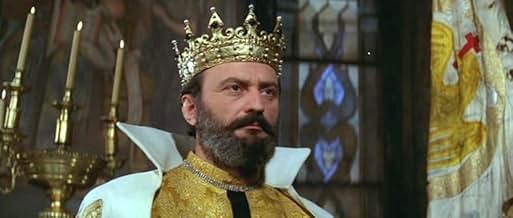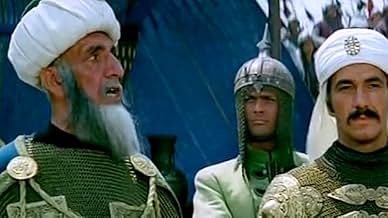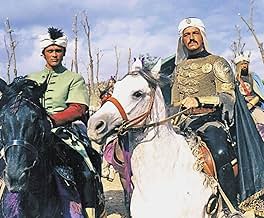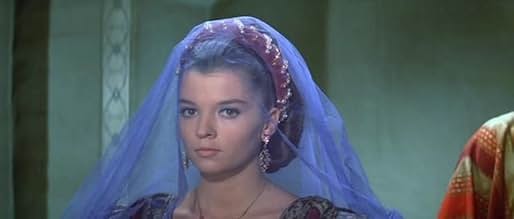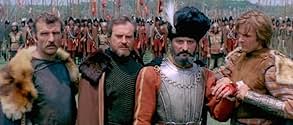Füge eine Handlung in deiner Sprache hinzuAt the end of the 16th century Wallachian ruler Prince Michael the Brave overcame the adversity of the Ottoman and Austrian Empires to unite Wallachia, Moldavia and Transylvania into one cou... Alles lesenAt the end of the 16th century Wallachian ruler Prince Michael the Brave overcame the adversity of the Ottoman and Austrian Empires to unite Wallachia, Moldavia and Transylvania into one country.At the end of the 16th century Wallachian ruler Prince Michael the Brave overcame the adversity of the Ottoman and Austrian Empires to unite Wallachia, Moldavia and Transylvania into one country.
- Auszeichnungen
- 8 Gewinne & 1 Nominierung insgesamt
- Maria Cristina de Graz
- (as Maria Clara Sebok)
- Pope Clement VIII
- (as Fory Eterle)
Empfohlene Bewertungen
Right after HBO's playing the film on 1st December 2000, a Romanian broadcasting network invited director Sergiu Nicolaescu to make a comment on his masterpiece. Everybody must know this was the second motion picture made by Sergiu Nicolaescu for the silver screen. First, the film was meant to be a co-production with the USA, thus Nicolaescu managed to cast Richard Burton, Elizabeth Taylor, Orson Wells and other great actors at Hollywood. However, the Ministry of Culture under President Nicolae Ceausescu did not admit an American involvement in a production based on the glorious history of the Romanian people. So, director Nicolaescu and writer Titus Popovici had to renounce to the American partnership and made this film on their own, financed by the Romanian government. A small dispute started between Nicolaescu and Popovici regarding the actor to play the main character, Mihai Viteazul. A number of 128 Romanian actors were tested for this role and the probes were sent in America, so that some American producers to choose which one is the appropriate actor for the character. The result was Sergiu Nicolaescu and that was exactly what Titus Popovici had in mind. So they started shooting with Nicolaescu playing Mihai Viteazul. But, after a while, Sergiu Nicolaescu was not pleased with the role, he actually wanted to play Selim-Pasa and went to the Ministry saying he's not going to direct that movie anymore, unless he is allowed to do it in his manner. He got the approval, except, of course, any American involvement in it. He returned on the director's chair, but with Amza Pellea playing the main character. I have to admit he was right, because Amza Pellea was outstanding and Nicolaescu's "Selim-Pasa" was a better part, I think.
All the battle scenes were filmed by only three cameras, without zoom effects (the Romanian film industry wasn't working with such equipments in the seventies), so all camera movements were created by physicals efforts.
Battle scenes were filmed with the Army's support, for which the director thanks during the main titles.
Historical facts are precise, that is Nicolaescu's guarantee. More than anything else, Sergiu Nicolaescu loves history, the Romanian history, and all important moments and dialogues in his historical movies are covered by documents from those periods.
Nicolaescu says he was surprised to notice a TV sequence in Steven Spielberg's "E.T." showing images from his film "Mihai Viteazul". That's why he asked, when he had the opportunity, Steven Spielberg why he enclosed a sequence from his movie and not from another director's. And Spielberg replied he admired Nicolaescu's work, especially the battle scenes, which also inspired him for some of his future films.
Mihai Viteazul was a Romanian ruler that reigned in the small principality of Wallachia between 1593 and 1601. In 1600 he bedazzled Europe by uniting Wallachia with Romanian-speaking Moldavia and Transylvania, for which he is hailed as Romania's national hero. It all sounds ferry tale-ish, but it isn't. Mihai was too ahead of his time. He had the guts to go to war with three empires (Turkish, Austrian and Polish) and found his death when he trusted one of them. But his accomplishment forged a landmark in Romanian history.
The movie:
First, it's the battle scenes. They don't come bigger than these and nobody can't take that away from Nicolaescu. He is THE master! Back then, when a movie of such girth was made in Romania, everybody got into it, from the head of state to the Army, so sky was the limit.
I think the grandest scene of the movie is the one depicting the Turkish army in the marshes of Calugareni on August 13 1595. On that day, the all-mighty Ottoman Empire, in its heyday at that time, poured 120,000 soldiers into Wallachia to conquer it. Imagine filming that! Nicoleascu shot from a helicopter. It started from the back, with the scattered extras forming the rear guard and gradually progressing towards the front. The scale is huge and mind you, he actually used that amount of people, not the CGI tricks of "Gladiator". Just think of the props and coordinating those guys on a hot day of summer in the middle of a swamp.
On the other side, as in every portrayal of a legendary figure, the hero hasn't the least of flaws: he is always brave (actually Mihai Viteazul means Michael the Brave), honest, nothing gets by him, always gives a moralizing speech before the battle yada yada. Man, didn't guys like Mihai or William Wallace ever had the slightest trace of egocentrism ? In that respect, there is another movie about Mihai Viteazul, called Buzduganul Cu Trei Peceti (The Mace With Three Seals), in which the hero actually has feelings, flaws and fears. Of course, it's directed by someone else.
At times, the acting is childish, especially in face-offs, like badly rehearsed lines of a play. When it involves a third party, e.g. a soldier telling Mihai that one of his subordinates has just arrived, I can't help myself laughing at the poor timing of the actors. Oh, and it's always the same thing with Romanian scripts: no matter whether the character is a farmer or the Austrian Emperor, he always uses the same old precious and dusty lingo, something like saying "It gives me great pleasure to gaze upon your look" instead of plain "Oh I'm so happy to see you".
All in all, I think 'Mihai Viteazul' is a good movie by most standards. It's the Romanian movie most seen outside its borders and a must-see within.
Wusstest du schon
- WissenswertesIn Steven Spielberg's E.T. - Der Außerirdische (1982) a scene from Michael der Tapfere (1971) can be seen on TV.
- PatzerAfter Andrew Báthory is beheaded you can see for a split second that the eyes on his head are blinking.
- Zitate
Sultan Murat III: I like you. Here, all you see is crawling backs, even those who have the hoofs of their horses full of Europe's and Asia's dust. But I could've not liked you. How could you dare?
Mihai Viteazul: We only have one life, almighty sultan!
Sultan Murat III: Indeed... Too bad!
- VerbindungenFeatured in E.T. - Der Außerirdische (1982)
Top-Auswahl
- How long is Michael the Brave?Powered by Alexa
Details
Box Office
- Budget
- 33.000.000 ROL (geschätzt)
Zu dieser Seite beitragen



